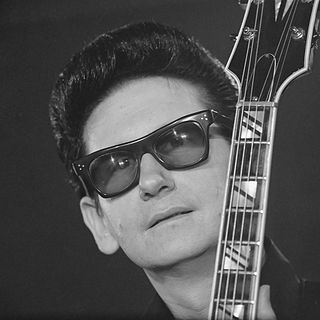
Roy Kelton Orbison was an American singer, songwriter, and guitarist known for his distinctive and powerful voice, complex song structures, and dark, emotional ballads. Orbison's music is mostly in the rock music genre and his most successful periods were in the early 1960s and the late 1980s. He was nicknamed "The Caruso of Rock" and "The Big O". Many of Orbison's songs conveyed vulnerability at a time when most male rock-and-roll performers projected strength. He performed with minimal motion and in black clothes, matching his dyed black hair and dark sunglasses.

U2 are an Irish rock band formed in Dublin in 1976. The group comprises Bono, the Edge, Adam Clayton, and Larry Mullen Jr.. Initially rooted in post-punk, U2's musical style has evolved throughout their career, yet has maintained an anthemic quality built on Bono's expressive vocals and the Edge's chiming, effects-based guitar sounds. Bono's lyrics, often embellished with spiritual imagery, focus on personal and sociopolitical themes. Popular for their live performances, the group have staged several elaborate tours over their career.

David Howell Evans, better known as the Edge or simply Edge, is a British-Irish musician, singer, and songwriter. He is best known as the lead guitarist, keyboardist, and backing vocalist of the rock band U2. A member of the group since its inception, he has recorded 15 studio albums with them as well as one solo record. His understated style of guitar playing, a signature of U2's music, is distinguished by chiming timbres, use of rhythmic delay, drone notes, harmonics, and an extensive use of effects units.
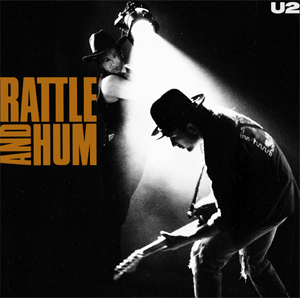
Rattle and Hum is a hybrid live/studio album by Irish rock band U2, and a companion rockumentary film directed by Phil Joanou. The album was produced by Jimmy Iovine and was released on 10 October 1988, while the film was distributed by Paramount Pictures and was released on 27 October 1988. Following the breakthrough success of the band's previous studio album, The Joshua Tree, the Rattle and Hum project captures their continued experiences with American roots music on the Joshua Tree Tour, further incorporating elements of blues rock, folk rock, and gospel music into their sound. A collection of new studio tracks, live performances, and cover songs, the project includes recordings at Sun Studio in Memphis and collaborations with Bob Dylan, B. B. King, and Harlem's New Voices of Freedom gospel choir.
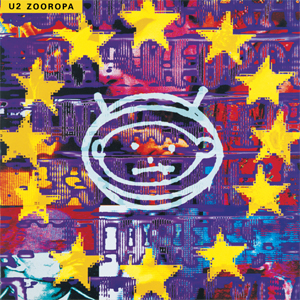
Zooropa is the eighth studio album by Irish rock band U2. Produced by Flood, Brian Eno, and the Edge, it was released on 5 July 1993 on Island Records. Inspired by the band's experiences on the Zoo TV Tour, Zooropa expanded on many of the tour's themes of technology and media oversaturation. The record was a continuation of the group's experimentation with alternative rock, electronic dance music, and electronic sound effects that began with their previous album, Achtung Baby, in 1991.

Mystery Girl is the twenty-second album by American singer Roy Orbison. It was his last album to be recorded during his lifetime, as he completed the album in November 1988, a month before his death at the age of 52, and it was released posthumously by Virgin Records on January 31, 1989. It includes the hit singles "You Got It", which was co-written by Orbison and his Traveling Wilburys bandmates Jeff Lynne and Tom Petty, and "She's a Mystery to Me", written by Bono and The Edge. The album was a critical and commercial success; it peaked at number 5 on the Billboard 200 in the United States, the highest position Orbison had achieved on that chart, and number 2 on the UK Albums Chart.

King of Hearts is a posthumous album of American singer Roy Orbison's songs put together from master sessions and demos by Jeff Lynne for Virgin Records, and Orbison's 23rd album overall. According to the authorized Roy Orbison biography, the collection was originally released in October 1992 on CD, music cassette, and LP.

Claude Demetrius was an American songwriter. He was known for his rockabilly songs, some of which were made famous by singers such as Elvis Presley.

"In Dreams" is a song composed and sung by singer Roy Orbison. An operatic rock ballad of lost love, it was released as a single on Monument Records in February 1963. It became the title track of the album In Dreams, released in July of the same year. The song has a unique through-composed structure in seven movements in which Orbison sings through two octaves, beyond the range of most rock singers.

"Miss Sarajevo" is a song by Irish rock band U2 and British musician Brian Eno, credited to the pseudonym "Passengers". It was released on 20 November 1995 as the only single from their album Original Soundtracks 1. Italian tenor Luciano Pavarotti makes a vocal appearance, singing the opera solo. The song was written about a group of women who held a beauty pageant during the Siege of Sarajevo as an act of defiance.

"I Still Haven't Found What I'm Looking For" is a song by Irish rock band U2. It is the second track from their 1987 album The Joshua Tree and was released as the album's second single in May 1987. The song was a hit, becoming the band's second consecutive number-one single on the US Billboard Hot 100 while peaking at number six on the UK Singles Chart.

"City of Blinding Lights" is a song by Irish rock band U2. It is the fifth track on their eleventh studio album, How to Dismantle an Atomic Bomb (2004), and was released as the album's fourth single on 6 June 2005. It was produced by Flood, with additional production by Chris Thomas and Jacknife Lee. The song reached number one in Spain, and peaked in the top ten in Canada, Ireland, the United Kingdom, and several other countries. The music video was shot at the General Motors Place in Vancouver, British Columbia, Canada.

"Hold Me, Thrill Me, Kiss Me, Kill Me" is a song by Irish rock band U2. It was released as a single from the soundtrack album for the film Batman Forever on 5 June 1995 by Atlantic and Island. A number-one single in their home country of Ireland, as well as in seven other countries, it reached number two on the UK Singles Chart, number sixteen on the US Billboard Hot 100, and number one on the Billboard Album Rock Tracks and Modern Rock Tracks charts. The song received Grammy Award nominations for Best Rock Performance by a Duo or Group with Vocal and Best Rock Song. The song is included on the compilation album The Best of 1990–2000 and the live album From the Ground Up: Edge's Picks from U2360°. Its music video was directed by Kevin Godley and Maurice Linnane.
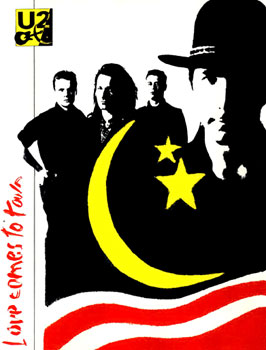
The Lovetown Tour was a concert tour by the Irish rock band U2, which took place in late 1989 and early 1990 following the release of Rattle and Hum. It was documented by noted rock film director Richard Lowenstein in the "LoveTown" documentary.
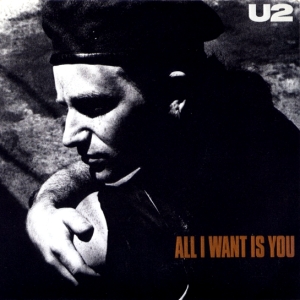
"All I Want Is You" is a song by Irish rock band U2. It is the final track on their 1988 album, Rattle and Hum, and was released as its fourth and final single on 12 June 1989. It also appears in the Rattle and Hum film, playing over the closing credits.

"Gloria" is a song by rock band U2. It is the opening track and second single from the band's 1981 album, October.

"You Got It" is a song from American singer Roy Orbison's 22nd studio album, Mystery Girl (1989). The song was released posthumously on January 3, 1989, after Orbison's death from a heart attack on December 6, 1988. The song was issued with "The Only One" as the B-side and was later released with "Crying". The single reached number nine on the US Billboard Hot 100 and number one on the Adult Contemporary chart, returning Orbison to the top 10 for the first time in 25 years. "You Got It" also reached number three on the UK Singles Chart and entered the top five in 10 other countries. Although it is an Orbison solo single, Orbison's fellow Traveling Wilburys bandmates Tom Petty and Jeff Lynne co-wrote the song and played instruments on the record.

"Oh, Pretty Woman", or simply "Pretty Woman", is a song recorded by Roy Orbison and written by Orbison and Bill Dees. It was released as a single in August 1964 on Monument Records and spent three weeks at number one on the Billboard Hot 100 from September 26, 1964, making it the second and final single by Orbison to reach number one in the United States. It was also Orbison's third single to top the UK Singles Chart, where it spent three weeks at number one.
This is a timeline of the history of rock band U2:

Songs of Surrender is an album of re-recorded songs by Irish rock band U2. Produced by guitarist the Edge, it was released on 17 March 2023 on Island Records and Interscope Records. Largely the effort of the Edge and lead vocalist Bono, the album comprises re-recorded and reinterpreted versions of 40 songs from the group's back catalogue, many in stripped-down and acoustic arrangements. The album is a companion to Bono's memoir, Surrender: 40 Songs, One Story (2022), which was structured into 40 chapters titled after U2 songs. Rearranged versions of the songs were first included in the audiobook edition of the memoir, and were performed by Bono during the book's promotional tour.



















